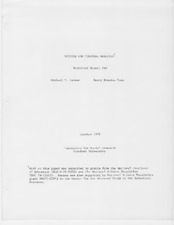| dc.creator | Hannan, Michael T | |
| dc.creator | Tuma, Nancy Brandon | |
| dc.date.accessioned | 2015-08-16T00:35:36Z | |
| dc.date.available | 2015-08-16T00:35:36Z | |
| dc.date.issued | 2015-08-15 | |
| dc.identifier.uri | https://hdl.handle.net/1969.1/154805 | |
| dc.description.abstract | The authors review sociological literature describing different perspectives and uses of studies of change in discrete (qualitative) and quantitative outcomes. They show that, contrary to many injunctions, temporal analysis is not always superior to cross-sectional analysis for studying change, particularly for two-wave panel measures. The main factor is whether confounding influences vary more over time than over measured outcomes. Modeling change processes and event history methods use more of the data and provide a better picture of change using temporal data. | en |
| dc.language.iso | en_US | |
| dc.relation.ispartofseries | Technical Report Stanford Sociology;#68 | |
| dc.rights | Attribution 3.0 United States | en |
| dc.rights.uri | http://creativecommons.org/licenses/by/3.0/us/ | |
| dc.subject | event history | en |
| dc.title | Methods for Temporal Analysis | en |
| dc.type | Technical Report | en |
| local.department | Sociology | en |



